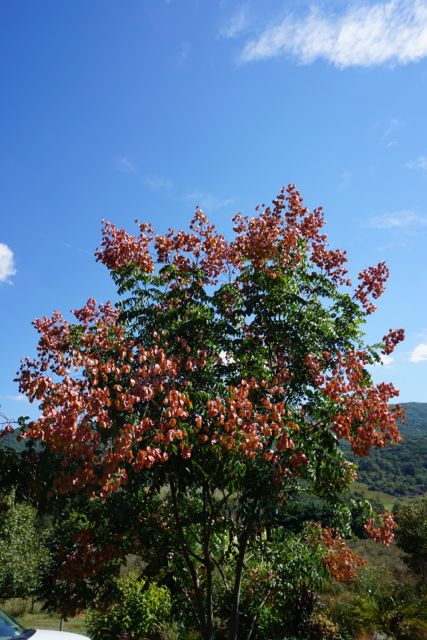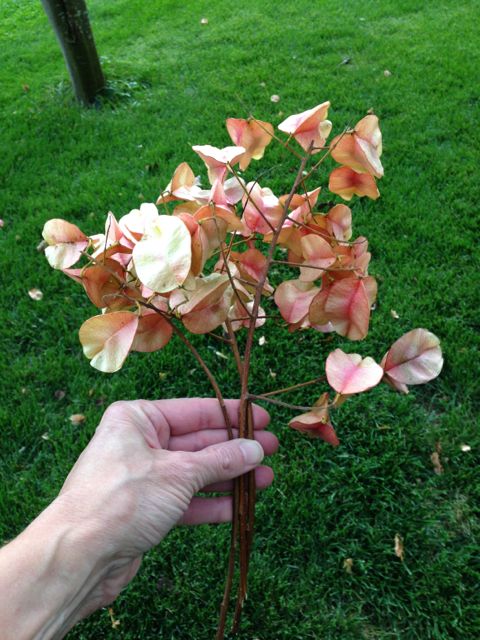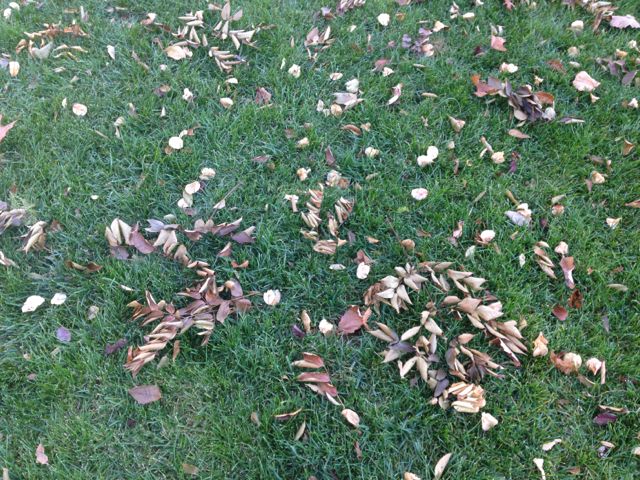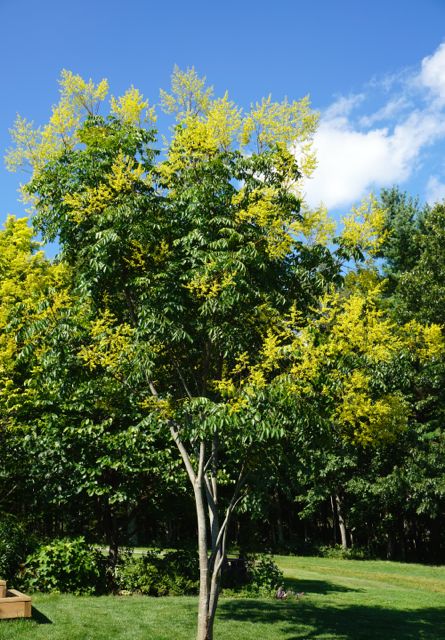You’ve probably heard certain plants dismissed as “trashy” – but what does that mean? We have a delightful Magnolia macrophyla in our campus garden – with huge foliage, creamy blooms, the native factor, etc., it draws all kind of attention. So I’d hesitate to call it trashy. But the autumn leaf drop clutters the ground with leaves the size of a sheet of legal paper. They aren’t rake-able, or really mow-able, have to gather by hand into “sheaves”. And there’s a LOT of them.
Here’s another example:
We plopped a 3-gallon Koelreuteria bipinnata (many common names, such as Chinese Flame Tree, Bougainvillea Golden Rain Tree, etc). into one of our home perennial borders a few years ago. As Dirr notes, it started out “beanpole-like in youth” but has grown into a nice vase shape. It hit puberty last year, with a smattering of flowers and fruit. This year has been a different story – I swear it doubled in size; and judge for yourself its full-on adulthood:
Late August and early September brought huge panicles of yellow flowers – eye-popping for us, and a late-season bounty of pollen and nectar for our honey bees (and every other bee and wasp in the area). You could hear the canopy “buzzing” from several yards away.
The yellow petals then fell away, carpeting the grass and part of our deck. It their place developed shrimp-pink, papery capsules.
 I cut one of the capsule-filled branches off; and a month later everything is still pink and intact in a vase of water. I also noted each of three capsule sections bears one dark round glossy seed. Uh-oh. That’s a lot of seeds.
I cut one of the capsule-filled branches off; and a month later everything is still pink and intact in a vase of water. I also noted each of three capsule sections bears one dark round glossy seed. Uh-oh. That’s a lot of seeds.
 With our first freeze, the leaves fell – in big chunks consisting of a tough foot-long petiole and a bunch of leaflets. My mower didn’t do a good job chopping them up – ended up having to rake and move to compost pile. What the mower DID do was fling the papery capsules far into other beds.
With our first freeze, the leaves fell – in big chunks consisting of a tough foot-long petiole and a bunch of leaflets. My mower didn’t do a good job chopping them up – ended up having to rake and move to compost pile. What the mower DID do was fling the papery capsules far into other beds.
 Flashy? Yes.
Flashy? Yes.
Trashy? Yes.
Invasive? Not sure yet. Will report back if seedlings appear!
Comments welcome – tell us about your favorite “trashy treasure”!

I wonder if we’ll get any hate mail from Arkansas?
http://libinfo.uark.edu/aas/issues/2006v60/v60a34.pdf
Our city planted these trees as a substitute for Chinese hackberry (problem being the Chinese hackberry aphid. which candycoats any thing parked underneath.) I attest that everyone of those little black seeds from the golden rain tree is fertile and grows anywhere it drops. I have almost as many seedlings from it as my Texas privet.
I don’t know if Koelreuteria paniculata is invasive, but it is a nuisance. How seeds roll halfway across my acre garden I can’t imagine, but closer to the tree there are thousands of seedlings each year. I suspect Koelreuteria bipinnata might do the same. Despite the troubles caused when the huge leaves fall my Bigleaf magnolia is treasured, the golden rain, not so much.
My Koelreuteria paniculata was felled by a storm but after a few years I now have a sizable tree again from a sprout next to the old stump. A very vigorous grower. As for seedlings I agree with the other commenters. I’d bet you’ll get quite a number of seedlings. However, I love the tree for all the qualities you mentioned in your post.
So IMO the headline of your article shouldn’t read “Trash or Treasure?” but “Trash and Treasure”. 🙂
The biggest issue with Koelreuteria is not being trashy – it’s extremely ornamental, tolerates urban environments and all their problems quite well and is relatively disease free. It is. however, highly invasive and, if planted in any proximity to a natural area, will propagate relentlessly to the dtriment of any native plant material.